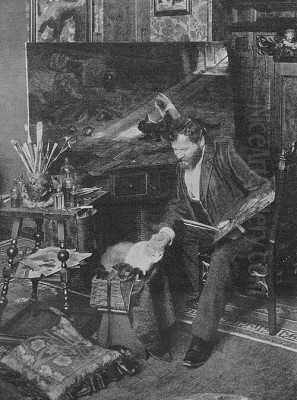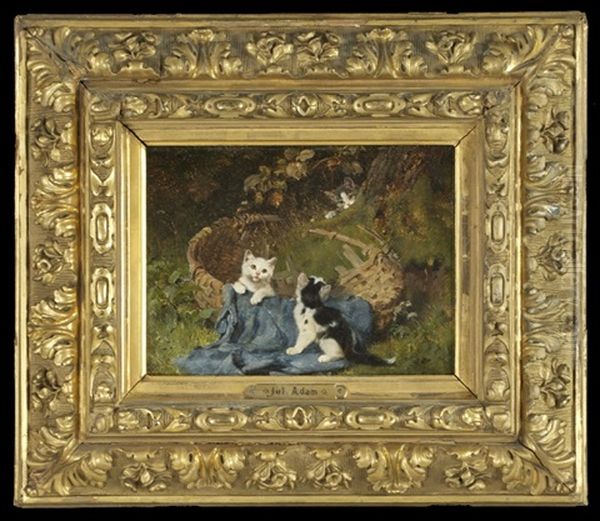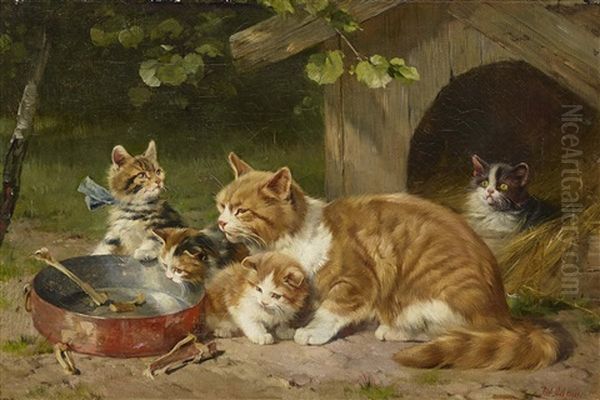
Julius Adam the Younger, often affectionately nicknamed "Katzen-Adam" (Cat Adam), holds a distinct place in the annals of German art, particularly within the vibrant Munich School of the late 19th and early 20th centuries. While his name might not resonate with the same immediate recognition as some of his contemporaries engaged in grand history painting or avant-garde experimentation, Adam carved a highly successful and enduring niche for himself through his charming, technically adept, and deeply empathetic depictions of domestic cats. His work, immensely popular during his lifetime and still appreciated today, offers a window into the tastes of the era and showcases a remarkable dedication to capturing the essence of his chosen subject.
An Artistic Dynasty: The Adam Family Legacy
Julius Adam the Younger was born into an environment steeped in artistic tradition on May 18, 1852, in Munich. He was a scion of the renowned Adam family, a dynasty of painters whose collective output significantly shaped the South German art scene for generations. The family's artistic patriarch was his grandfather, Albrecht Adam (1786–1862), a celebrated painter famed for his depictions of horses, battle scenes (notably accompanying Napoleon's campaigns), and portraits. Albrecht's success established the family's reputation and artistic direction.
Julius's father was Benno Adam (1812–1892), himself a highly respected animal painter. Benno specialized in depicting hunting scenes, domestic animals, and particularly dogs and farm animals, continuing the family's affinity for animal subjects but shifting focus from the predominantly equine and military themes of his father. Growing up under Benno's influence undoubtedly provided Julius with early exposure to the techniques and sensibilities required for animal portraiture, laying a crucial foundation for his future specialization.

The artistic lineage extended further through his uncles. Franz Adam (1815–1886) followed closely in his father Albrecht's footsteps, gaining renown for his equestrian portraits and dynamic battle paintings, particularly scenes from the Hungarian campaigns and the Franco-Prussian War. Another uncle, Eugen Adam (1817–1880), also pursued military and genre themes, often depicting scenes from contemporary conflicts with meticulous detail. This familial backdrop meant Julius was immersed in discussions of technique, composition, and the art market from a young age, inheriting not just potential talent but also a practical understanding of the artistic profession.
Formal Training and Early Career
While the Adam family provided a rich, informal education, Julius Adam the Younger also sought formal training to hone his skills. He enrolled at the prestigious Academy of Fine Arts in Munich, a major center for artistic education in Germany at the time. There, he studied under notable figures such as Michael Echter (1812–1879), a history painter known for his work on decorative cycles, and later, more significantly, under Wilhelm von Diez (1839–1907).
Wilhelm von Diez was a highly influential professor at the Munich Academy, known for his realistic genre scenes, historical subjects, and animal paintings, often characterized by a painterly technique and keen observation. Studying under Diez would have reinforced Julius's inclination towards realism and provided him with rigorous training in drawing, anatomy, and composition, essential skills for the detailed animal depictions he would later master. The Munich Academy during this period was a hub for realism, influenced partly by the Barbizon School and Gustave Courbet, fostering an environment where technical proficiency and accurate observation were highly valued.
Interestingly, before fully committing to painting, Adam embarked on a different path for a period. He spent several years working in Rio de Janeiro, Brazil. However, his work there was primarily in the field of landscape and portrait photography, a burgeoning medium at the time. This experience, though seemingly divergent, may have sharpened his eye for composition, light, and capturing likeness – skills transferable back to painting. Upon his return to Munich around 1882, he made the decisive shift to dedicate himself entirely to painting, drawing upon his family heritage and formal training.
The Emergence of "Katzen-Adam"
Upon resettling in Munich, Julius Adam the Younger began to focus intensely on genre painting, and it was his depictions of cats that quickly brought him widespread acclaim. While his father Benno was known for dogs and farm animals, Julius found his true calling in portraying the domestic cat in all its varied moods and activities. This specialization earned him the affectionate and enduring nickname "Katzen-Adam," distinguishing him clearly from other members of his artistically prolific family.

His timing was fortuitous. The late 19th century saw a rise in the popularity of domestic pets among the growing middle class, and genre scenes depicting everyday life, including interactions with animals, were highly sought after. Adam's paintings tapped directly into this sentiment. He moved beyond simple animal portraiture to create narrative vignettes centered around cats, particularly kittens. His canvases often featured fluffy, playful groups tumbling out of baskets, curiously exploring household objects, or interacting with each other with an uncanny realism that resonated deeply with viewers.
The demand for his work grew rapidly. His paintings were not only acquired by private collectors but were also widely reproduced as prints and postcards, disseminating his charming feline imagery far beyond the confines of Munich's galleries. This commercial success solidified his reputation and made "Katzen-Adam" a household name, synonymous with delightful and expertly rendered cat paintings. He became a regular exhibitor at major venues like the Munich Glaspalast, further cementing his status within the contemporary art scene.
Artistic Style and Technique
Julius Adam the Younger's style is firmly rooted in the realism characteristic of the Munich School in the latter half of the 19th century. His primary goal was the accurate and detailed representation of his subjects, particularly the texture of fur, the play of light on form, and the specific anatomy and posture of cats. He possessed a meticulous technique, rendering individual hairs and subtle shifts in coloration with remarkable precision, giving his feline subjects a tangible, lifelike quality.
His compositions are typically intimate and focused, often set within simple domestic interiors. Props like baskets, cushions, milk bowls, or pieces of furniture serve to frame the cats and provide context, enhancing the narrative element of the scene. Adam demonstrated a keen understanding of animal behavior, capturing the characteristic curiosity, playfulness, laziness, or cautiousness of cats. Whether depicting a litter of kittens exploring their surroundings or a solitary cat enjoying a nap in a sunbeam, his paintings convey a sense of genuine observation and empathy.
Light plays a crucial role in his work. He often employed warm, soft lighting, reminiscent of indoor settings, which enhanced the cozy, domestic atmosphere of his paintings. This careful manipulation of light and shadow helped to model the forms of the cats, adding depth and volume to their figures. While highly detailed, his brushwork remained controlled and refined, avoiding the looser, more impressionistic handling of paint adopted by some of his contemporaries, such as the later animal painter Heinrich von Zügel (1850-1941), another prominent figure associated with the Munich scene known for his more dynamic, light-filled depictions of livestock. Adam's commitment remained closer to the detailed realism favored by artists like Anton Braith (1836-1905), known for his paintings of cattle.
Notable Works and Recurring Themes
While specific titles varied and many works share similar themes, certain compositions by Julius Adam the Younger became particularly iconic and representative of his oeuvre. Paintings frequently titled Kittens at Play, A Basket of Kittens, Siesta, or An Important Question exemplify his focus. These works typically showcase his mastery in depicting the soft fur, expressive eyes, and characteristic poses of young cats. He excelled at capturing the chaotic energy of multiple kittens interacting, tumbling over each other in play, or peering curiously out from the confines of a basket or box.
A recurring theme is the exploration of feline nature within a human domestic environment, though humans themselves are rarely depicted. The settings imply human presence – a tidy room, a discarded piece of yarn, a bowl of milk – but the cats are the undisputed protagonists. This allows the viewer to focus entirely on the animals' world, their social interactions, and their individual personalities as perceived by Adam. Works like The Intruder, which might depict a kitten encountering another animal or an unfamiliar object, add a gentle narrative tension.
Other compositions, sometimes titled Cat Concert or similar, might anthropomorphize the cats slightly, arranging them in ways that suggest a shared, almost human-like activity, yet always grounded in realistic portrayal. His ability to render the silky texture of a Persian cat's long fur or the sleek coat of a shorthair with equal dexterity was a hallmark of his skill. These works, consistently charming and technically polished, cemented his reputation and ensured their enduring appeal to a wide audience who appreciated the blend of realism and sentiment.
Context within the Munich School
Julius Adam the Younger operated firmly within the context of the Munich School, the influential movement centered around the city's Academy of Fine Arts during the 19th and early 20th centuries. This school was characterized by its emphasis on realism, technical proficiency, and often, a focus on genre painting, portraiture, and landscape. Adam's detailed style and subject matter align well with these tendencies.
He was a contemporary of major figures associated with Munich realism, although his focus was narrower. Artists like Wilhelm Leibl (1844–1900) pushed realism towards an almost photographic intensity in depictions of peasant life. Franz von Lenbach (1836–1904) became famous for his psychologically insightful portraits of prominent figures like Bismarck. Carl Spitzweg (1808–1885), from an earlier generation but whose influence lingered, captured the charming, slightly eccentric world of the Biedermeier era in his small-scale genre scenes.
Within the specific field of animal painting in Munich, Adam followed in the footsteps of his father Benno and grandfather Albrecht, but also worked alongside contemporaries like Anton Braith and Friedrich Voltz (1817–1886), both known for their realistic depictions of cattle and pastoral landscapes. While Braith and Voltz often focused on livestock within broader landscape settings, Adam concentrated on the intimate domestic sphere. Later, Heinrich von Zügel would bring a more impressionistic, light-filled approach to animal painting in Munich. Adam's style remained more traditional and detailed compared to Zügel's looser brushwork. His specialization in cats also set him apart, much like the Dutch artist Henriëtte Ronner-Knip (1821–1909), who gained international fame for her similarly charming and detailed paintings of cats and kittens in bourgeois interiors.
Exhibitions, Recognition, and Later Life
Julius Adam the Younger enjoyed considerable success and recognition during his career. He was a regular participant in the major art exhibitions held in Munich, most notably at the Glaspalast (Glass Palace), the city's primary venue for large-scale art shows until its destruction by fire in 1931. His works were consistently popular with both critics and the public at these exhibitions, praised for their technical skill and appealing subject matter. He also exhibited in Berlin and other German cities, further broadening his reputation.
His popularity translated into commercial success. His paintings commanded good prices, and the widespread reproduction of his work in print form provided a steady stream of income and fame. He catered effectively to the tastes of the Wilhelmine era's bourgeoisie, who appreciated art that was skillful, accessible, and reflected the comforts of domestic life. The "Katzen-Adam" moniker was a mark of this widespread public affection and recognition.
He remained active as a painter in Munich throughout his later years, continuing to produce the feline portraits that had become his signature. His dedication to his specific niche was unwavering, and he maintained a high level of technical quality in his output. Julius Adam the Younger died in his native Munich on September 23, 1913, at the age of 61, leaving behind a substantial body of work that continues to delight cat lovers and admirers of skilled realist painting.
Legacy and Art Historical Assessment
Julius Adam the Younger's legacy is primarily tied to his mastery of a specific genre: the domestic cat painting. While not an innovator in the sense of pushing artistic boundaries or engaging with avant-garde movements, he achieved excellence within his chosen field. His work represents a high point of animalier painting within the Munich School tradition, characterized by meticulous realism, technical polish, and a genuine empathy for his subjects.
Art historically, he is often categorized as a skilled genre painter whose work reflects the popular tastes and sentimental tendencies of the late 19th and early 20th centuries. His paintings lack the social commentary of Leibl or the psychological depth of Lenbach, but they possess an undeniable charm and technical virtuosity. The enduring popularity of his images, still frequently reproduced today, attests to their lasting appeal. He successfully captured the essence of feline behavior and personality in a way that continues to resonate with viewers.
While perhaps overshadowed in broader art historical narratives by artists tackling grander themes or more radical styles, "Katzen-Adam" remains a significant figure within the context of Munich art and the specialized field of animal painting. He represents the continuation of the Adam family's artistic dynasty, adapting their tradition of animal depiction to suit the sensibilities of his time. His dedication to his craft and his ability to elevate the humble domestic cat to the status of a worthy artistic subject secure his unique place in German art history. His work serves as a reminder that artistic merit can be found in focused specialization and the skillful, affectionate portrayal of the familiar world.